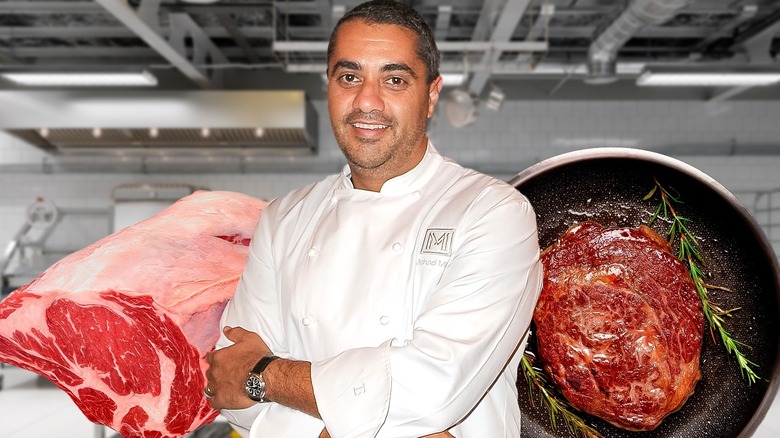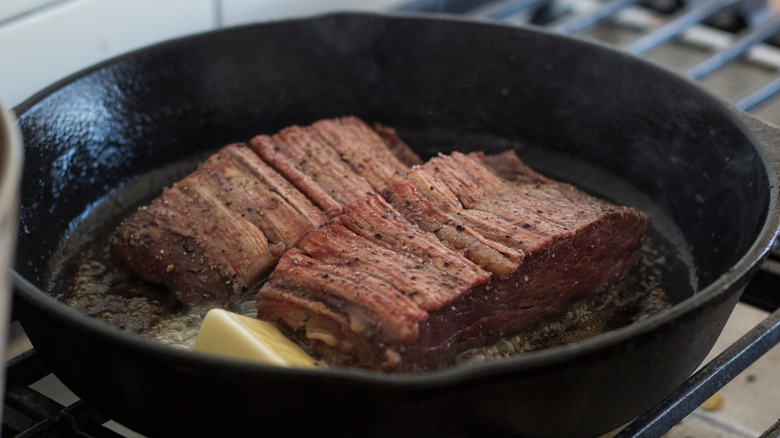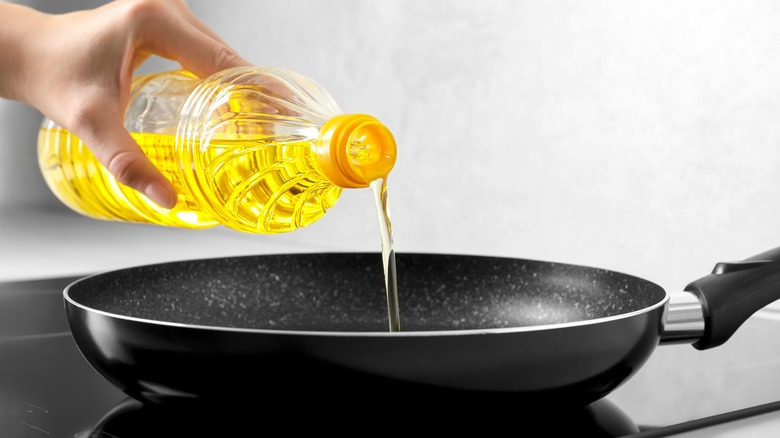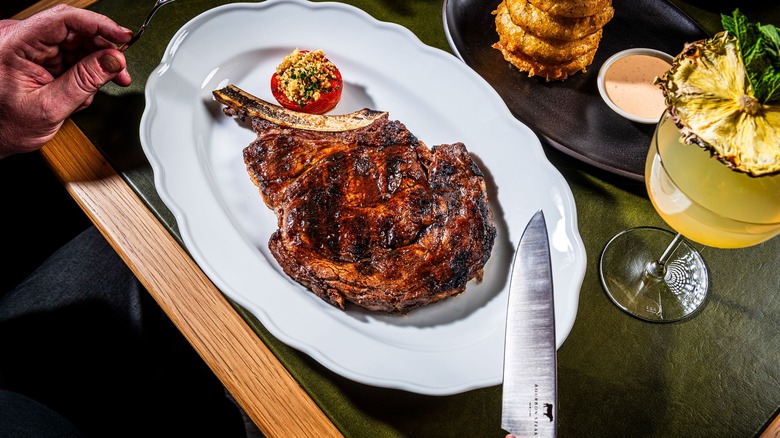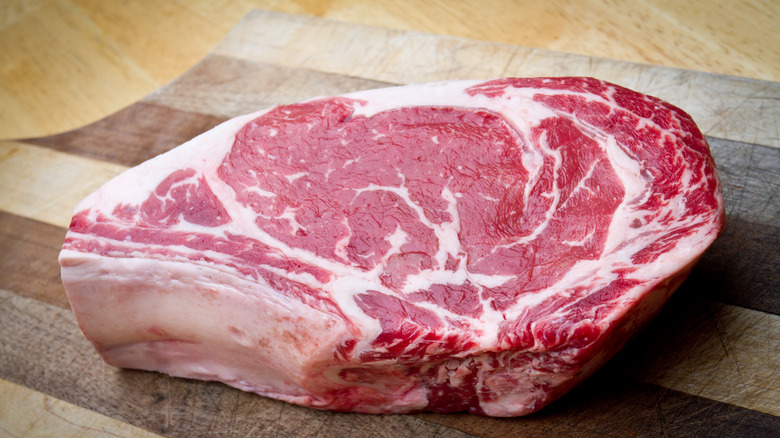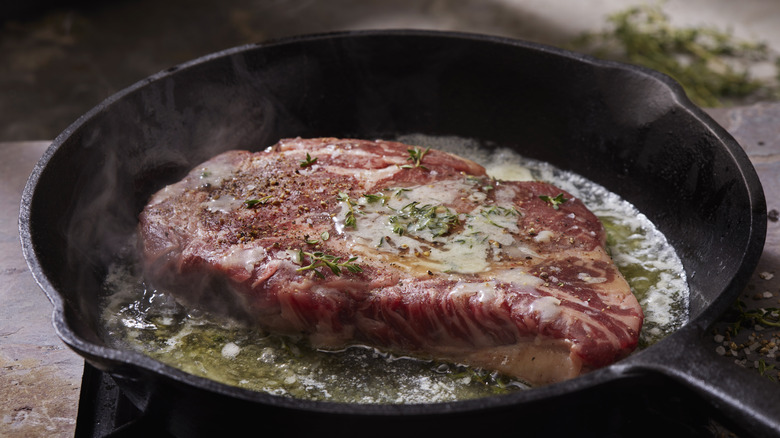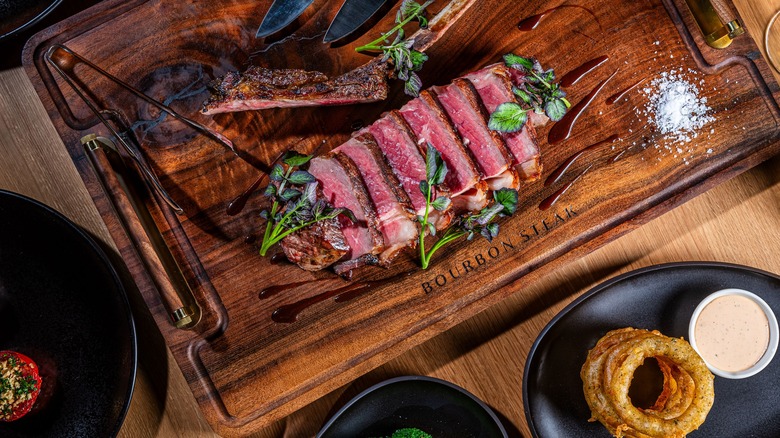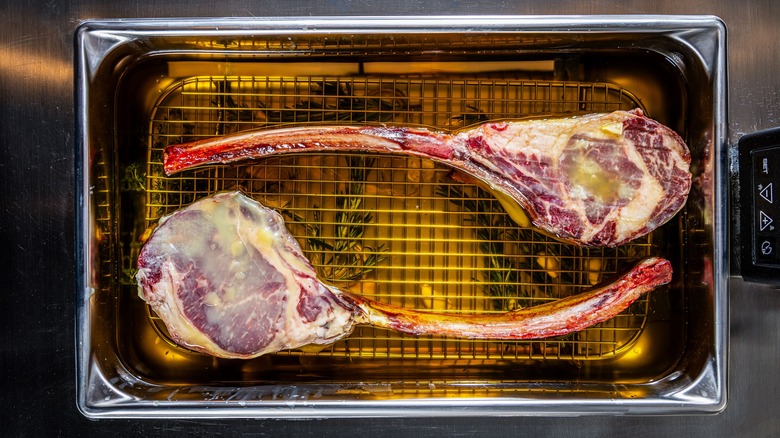Michelin-Starred Chef Michael Mina's Best Tips For Cooking Steak
Is there any meal quite as intimidating as the homemade steak dinner? Forget about figuring out which sides to prepare alongside your meat; there's finding the right cut of meat and seasoning it properly — whether with a dry rub or a marinade — and then deciding how you're going to cook it. And what about cooking temperatures? You have your own preference, but if you're cooking for a crowd, you may want to cook each steak to your guest's desired doneness. Cooking steak at home is like solving a puzzle; all the pieces are there, and it's up to you to figure out how to put them all together. Luckily, you're not in this alone.
Chef Michael Mina — restaurateur, cookbook author, and founder of the Mina Group — knows a thing or two about cooking steak. As the owner of over 30 restaurants, including eight locations of famed Bourbon Steak, Mina has been preparing his exotic, primal cuts of beef for diners for over 30 years. As chef Mina celebrates the opening of Bourbon Steak's first New York City location and his first New York City restaurant, we had the chance to talk to him about steak in all its splendor, and what steak cooking tips he recommends for the home cook. If the idea of cooking a steak at home sounds like a hot pan of anxiety, fear not. We've got you covered.
Why the rib cap is about to be your new favorite cut of steak
Ribeye. Filet mignon. Porterhouse. Bavette. When considering the best cuts of meat, these are the first to come to mind. Glistening with fat, seared and crispy on the outside and juicy on the inside, for the most carnivorous of us, these cuts of meat get us excited to eat at a steakhouse. However, chef Michael Mina recommends looking at a slightly off-the-beaten-path cut of meat that delivers on flavor and then some. That cut? The rib cap.
Located on the top end of the ribeye in between all the fat, the rib cap is the unsung hero of this pristine cut of meat. "The rib cap is that little piece that is overcooked on top, but is so delicious," describes Mina. "[It's] more tender than a filet and has more flavor than a ribeye." That tender, melt-in-your-mouth texture comes from the rib cap not being used much for movement, resulting in a luscious, fatty bite, not a lean one.
Cost-wise, the rib cap will cost you about the same as a ribeye steak, about $18-$22 per pound depending on your butcher and the quality of the meat, according to Mina. He recommends a simple preparation for rib cap: brush with olive oil, season with salt and pepper, and grill. The fairly marbled cut will release a lot of juice and fat that will have you wondering what you've been missing out on all this time.
Find the right cooking fat
When it comes to finding the right fat to cook your steak in, you've got options. However, before you reach for that bottle of olive oil in your pantry, take a beat. To avoid a burnt, unevenly cooked steak with a bitter taste, avoid using any unrefined oils with a low smoke point, such as non-clarified butter which has a smoke point of 302 degrees Fahrenheit, or extra virgin olive oil, which has a smoke point of 325 degrees Fahrenheit. Using these types of fat on your searing hot pan or grill will turn that once beautiful steak into a bitter-tasting disaster.
For the best results on the grill or in a pan, chef Micahel Mina recommends clarified butter, ghee, or grapeseed oil, all of which have high smoke points. Before oiling anything, season your grill heavily, get it ripping hot, and then brush it with the oil of your choice. For something a bit fancier, Mina suggests a little duck fat, which also has a high smoke point but will also add some rich flavor as well. For the most even char on your meat, marinade the night before with grapeseed oil, herbs, sliced garlic, and onions. Don't forget to remove the herbs before you throw the steak on the grill.
Marinade vs. dry rub
No matter how you choose to cook your steak, you've got to season it first. The purpose of the pre-season, whether it's a bourbon marinade or a spicy dry rub, is for flavor. However, not all cuts of steak are created equal, and that goes for how to best pre-season your meat before cooking it. But how do you determine which option is best for you?
"It depends on the fattiness of the cut," says chef Michael Mina. "What's soaking up the marinade is the fat. And it depends on who you are." Choosing a marinade versus a dry rub comes down to the cut of meat, as well as personal preference. For example, a skirt steak can bathe in a marinade of your choosing for up to 24 hours, hit the hot grill, and immediately start to caramelize. The marinade works in your favor here because the fat in the meat will soak up the flavors in the marinade, resulting in a more well-seasoned, tender steak. However, a leaner cut, like a filet mignon, benefits more from a dry rub to keep it from drying out while cooking.
If going the dry rub route, you can easily make one at home. For a straightforward steak and baked potato dinner, salt and fresh cracked black pepper crust will get the job done. For something a little more exotic and robust, a coffee rub on steak adds depth of flavor with just a little bit of heat.
Cook your steak at room temperature to hold onto the juices
You've picked up your beautiful steak from the butcher and brought it home. You've been waiting all week to cook yourself a nice steak dinner, and now's the time. Naturally, you put the steak in the refrigerator and wait until it's dinner time, then pull the steak out and immediately throw it on the grill, right? For the sake of your steak and your own taste buds, the answer is an unequivocal no.
"The longer you're cooking your meat to get it to ... temperature, the more juice you're releasing," says chef Michael Mina. "That juice is the fat, the flavor in the meat." To avoid overcooking your steak and achieve the internal temperature of your choice, chef Mina recommends pulling your steak out well before you plan to cook it, giving it time to get up to room temperature. If your goal is a charred outside and a raw inside, the direct-from-the-fridge route is certainly an option. For a steak with a little more nuance, give it a little time outside the chiller.
According to Mina, the worst way to cook a steak is to quickly grill it on both sides and then throw it in the oven, allowing all the beautiful juices to release to the bottom of the pan. Those juices are where the flavor lives, and by releasing them, you're saying goodbye to the best part of the steak.
Pick the right pan for steak on the stovetop
While a steak cooked on the grill is the gold standard, it's not always an option. Perhaps you live in an apartment without access to an outdoor grill, or you don't consider yourself much of a grill master. Not having a grill shouldn't hinder your access to a beautifully prepared steak, and it won't. If a pan is what you have to work with, there are plenty of good ones to choose from.
Chef Michael Mina's top recommendation for a traditional, reliable pan? Cast iron. Its ability to conduct and retain heat evenly is what makes it an ideal vehicle for cooking a good steak on the stove. And as much as the internet will have you believe that a good cast iron pan will cost you a tiny fortune, there are plenty of top-tier cast iron brands that won't break the bank. Additionally, if you take the time to properly season and take care of your cast iron pan, it will last you a lifetime.
Alternatively, there are other pan options that aren't cast iron that will still deliver fantastic results. Chef Mina suggests looking for a thick-bottomed pan, either nickel-plated or copper. These materials are heat conductors and hold heat evenly, ensuring your steak gets an even sear on both sides every time.
Determine every steak temperature using the palm of your hand
If you've ever ordered a steak at a restaurant, you know the most important question is "and how would you like that cooked?" At the right steakhouse with the right chef running the grill, you're bound to get what you asked for. However, for the home cook dipping a toe into cooking steak for the first time, achieving that perfect internal steak temperature can be daunting. The key, chef Michael Mina says, is right in your hand.
Look at the palm of your hand, he recommends. The center, fleshy part of your palm, just below your thumb, is rare to medium rare (130 to 138 degrees Fahrenheit). Move it a little farther over, and it's medium (140 to 145 degrees Fahrenheit). The farther away you get from that squishy part and the closer to your pinky, the closer you get to well done (anything above 155 degrees Fahrenheit). If you can get familiar with that feeling on your steak, you'll always get the temperature you want.
For something slightly more accurate, chef Mina recommends buying a meat thermometer and a cake tester. Once you reach the temperature you want, put the thermometer to the bottom of your lip, and then your hand to get a feel for the different temperatures. After you've got that down, try it again with the cake tester. The thin metal stick will give you a more precise reading without losing any steak juice.
The key to a great steak is in the heat
It's easy to equate a high-end cut with a perfect steak, but according to chef Michael Mina, this is a common misconception. For him, achieving a well-cooked steak isn't in the meat; it's in the heat. Specifically, the heat on your grill or pan. If you can learn your grill or pan and all its heat variations, you'll be able to cook any cut of steak perfectly, every time.
That said, don't fall into traps. "I think the whole idea of browning a steak really hot on both sides and then oven cooking to finish ... [is] not a good way to cook a steak," said Mina. For a more foolproof method, he recommends trying a butter baste or butter poach method, which uses hot butter to seal in the juices while also slowly cooking it to your exact temperature preference.
Learning your grill requires practice, so get to it. Experiment with different cuts of steak; make sure to leave space on your grill to flip the meat onto another hot spot so you can get an even sear on both sides. For the first-time griller who wants to get started with a simpler cut, chef Mina recommends going for a 12 to 14-ounce New York strip. The long cut is easy to poke on the sides, has a good amount of fat, and because of its style and dimensions, it's easier to find your desired temperature.
